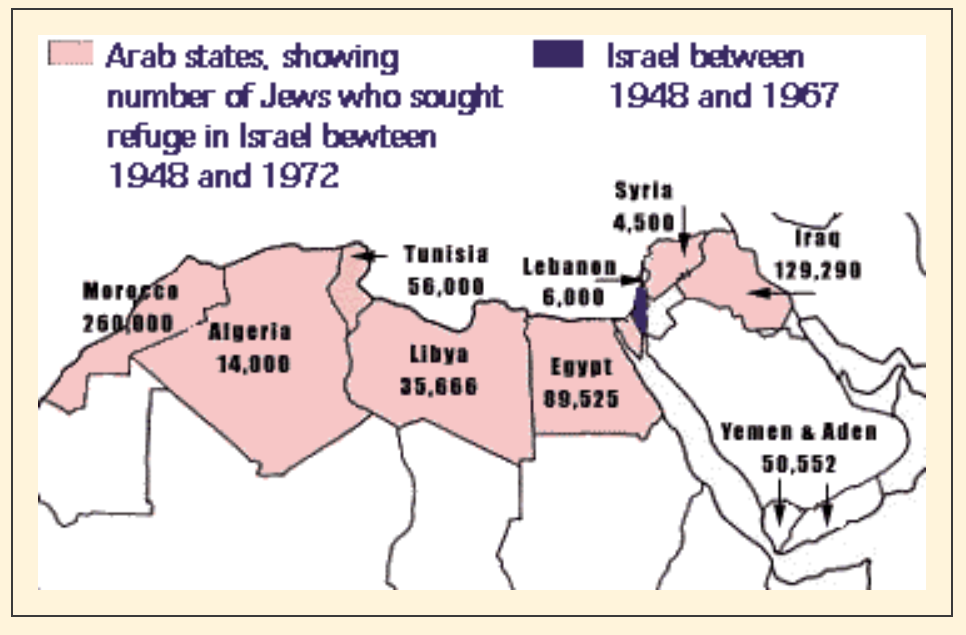Hamas' unprecedentedly powerful and brutal attack on Israel has 7/10 also led to an unprecedentedly powerful Israeli counter-operation in Gaza, resulting in an unprecedented humanitarian crisis for the civilian population of Gaza. Based on this, the international community has demanded an immediate ceasefire, which is not happening, however, because Hamas has refused to release its hostages and lay down its weapons, and because Israel wants to eliminate Hamas' military power and release the hostages. According to Israel, the military operation against Hamas may take several more months, and therefore there is no quick help for the humanitarian crisis.
In order to solve the humanitarian crisis of the Gazans immediately, to rebuild the destroyed Palestinian territory in the medium term and to implement the Two-State solution in the long term, there is a pragmatic and feasible plan in which the primary winners would be the Gazans and Israel, the secondary beneficiaries would be Egypt and the Palestinians, and thirdly the USA and the broad international community.
The solution described above is based on Egypt's initiative - Sinai Option - presented in previous years to expand the Gaza Strip to multiple times its current size, to build apartments, a community structure and a viable economy in this area for Gazans and other willing Palestinians, and in the long term to form the area into either an independent demilitarised autonomy belonging to Egypt or a Palestinian state together with the Palestinians of the West Bank.
History of the Sinai option
The Sinai option indeed is not a new option to solve Egypt-Gaza-Israel conflict. According Middle East Monitor (MEMO) report [01 September 2014] Egypt offered Palestinian Authority’s President Abbas a Palestinian state in Sinai. Egyptian President Abdel-Fattah el-Sissi offered Palestinian Authority 620 square miles of land adjacent to Gaza in exchange for relinquishing claims to 1967 borders for the purpose of establishing a Palestinian state. PA President Abbas reportedly rejected proposal. Speaking in a meeting of Fatah leaders in Ramallah, Abbas said: “The plan, which was proposed in 1956, included annexing 1,600 square kilometres [620 sq mi] from the Sinai Peninsula to the Gaza Strip in order to receive Palestinian refugees.” He continued: “The plan is being proposed again, but we refused it.”
At its core, the Egyptian initiative proposes expanding the Gaza Strip to five times its current size and settling all the Gazans and Palestinian refugees in a state to be established there. In addition, the Palestinian Authority would be granted autonomy in the Palestinian cities in the West Bank in exchange for relinquishing the Palestinian demand to return to 1967 borders.
According Middle East Eye (MEE) the scheme became the centrepiece of the 2004 Herzliya conference, an annual meeting of Israel’s political, academic and security elites to exchange and develop policy ideas. It was then enthusiastically adopted by Uzi Arad, the conference’s founder and long-time adviser to Benjamin Netanyahu, the current prime minister. He proposed a three-way exchange, in which the Palestinians would get part of Sinai for their state, while in return Israel would receive most of the West Bank, and Egypt would be given a land passage across the Negev to connect it to Jordan.
Phase I: Solving the humanitarian crisis
When Gaza's already poor water and waste water supply has been partially destroyed, the energy supply is at a minimum, the roads have been largely destroyed and the remaining hospitals are operating at their limits, a humanitarian crisis has emerged in a situation where the majority of Gazans have had to move away from the fighting to safer areas.
As the war against Hamas drags on, humanitarian aid has been very difficult to both deliver and distribute to Gazans in need. The situation will not improve much by increasing transport through Rafah and Kerem Shalom, because the number of people needing help is too large, the safe areas too small, and because even under them there may be underground structures of the Gaza metro that will continue to be destroyed.
The only practical and quick solution is to build a temporary settlement for the Gazans on the border between Egypt and Gaza, in which case the Gazans who have moved to the safe areas of southern Gaza only need to move a few kilometres southwest of their current positions.
Gaza has been held hostage by Hamas, Palestinian Islamic Jihad (PIJ) and other terrorist organisations committed to Israel’s destruction. Israel has tightened security over Gaza in order to prevent weapons, and materials that are used to make weapons, from entering. However Gaza has also been a safe haven for terrorists (e.g. Daesh) who have been attacking Egypt's military and civil infrastructure. The group that has claimed the vast majority of Sinai attacks is Ansar Bayt al Maqdis (ABM): an Egyptian group founded in approximately 2011, which has reportedly less than 1,000 members. While the group’s original aim was to work against Israel, ABM now also targets the Egyptian security state and the country’s economic interests. ABM has loose links to al Qaeda franchise. In 2014, elements of the Ansar Bait al-Maqdis group pledged allegiance to the Islamic State of Iraq and the Levant (ISIL/ISIS) and proclaimed themselves Sinai Province, and a part of ISIS.
Acceptable solution for the humanitarian crisis of Gaza must allow goods and services to pass through to humanitarian zones while making sure Israel’s and Egypt’s legitimate security concerns are addressed. In order to prevent the spread of terrorism to the new humanitarian safe zone, the security authorities of Egypt and Israel must check all at least male persons in order to find out their possible connections with Hamas, PIJ and the like.
The international community already has a lot of experience in building such temporary refugee camps quickly, for example, after various natural disasters. Here an example about field hospitals:
Example: The field hospital
The international aid community has many challenges, for example, in the health care of Gazans: Treating the wounded, addressing the medical and psychosocial needs of the displaced populations, meeting routine medical needs of under-served local populations, and strengthening resilience through capacity building of the disrupted local healthcare system.
In response to reports by Gazans and news media that the Earlier during 2014 Israel–Gaza conflict IDF opened a field hospital at Erez Crossing on July 20, 2014, intending it to be for sick and injured Palestinians from Gaza.
Newest example about field hospitals is from Ukraine where Israel, which in all its past humanitarian missions deployed military field hospitals, decided, for the first time, to deploy a civilian field hospital.
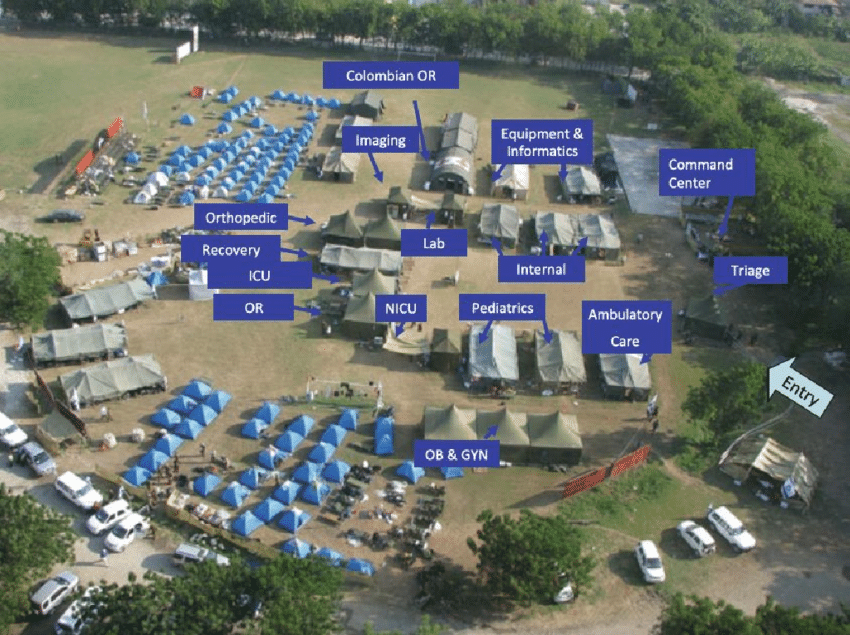
Layout of IDF Field Hospital. Credit: Farfel et al, 2011
According the Journal of global health It was probably the only state-level foreign field hospital deployed in Ukraine. This unique mission required addressing immediate challenges in the pre-deployment phase: Understanding the exact medical needs, defining essential logistic and security requirements, coordinating with the local government, and designing the field hospital accordingly. A Rapid Assessment Team was dispatched and worked in close collaboration with The Israeli Ministry of Foreign Affairs team on the ground and with The Ukrainian health and local authorities.
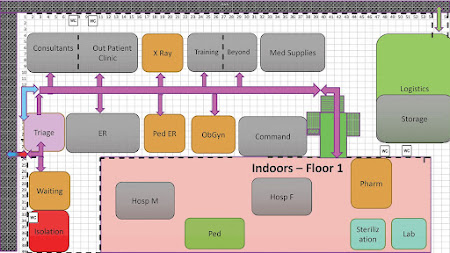
The hospital commenced operation on March 22, 2022 and was operational for six weeks. During this period 6161 patients were treated in the hospital of which 954 were children. Source: Sheba Medical Center.
The conditions treated ranged from chronic non-communicable diseases such as hypertension, diabetes and osteoarthritis, to acute and emergency conditions including, among others: infections, myocardial infarction, hypertensive crisis, acute appendicitis, acute cholecystitis, perforated duodenal ulcers and fractures. 65 patients were hospitalised and 59 patients underwent surgery. 103 patients had consultations utilising telemedicine technologies. 995 patients had laboratory tests, and 846 patients underwent imaging studies.
IDF has experience building Type 3 field hospitals (with 40 inpatient beds and two operating rooms capable of performing 15 to 30 surgeries per day along with other services, including rehabilitation) in less than 24 hours per hospital. Also the United Arab Emirates (UAE) has good ability for field hospitals; e.g. for earthquake victims in Türkiye the hospital began operating four days after twin earthquakes hit southern Türkiye on Feb. 6 2023, employing 50 personnel with 15 doctors.
Phase II: Reconstruction of the New Greater Gaza
After previous conflicts, Gaza has been rebuilt again and again, however, with Hamas always taking part of the funds intended for reconstruction for its own use, e.g. the construction of the Gaza Metro, missile and weapon production, and the luxury life of its elite. If the same thing happens again, there will be no significant improvement in the lives of Gazans after the humanitarian crisis. A significant reason for adopting the Sinai option is that with most of Gaza's infrastructure destroyed, clearing the area would take significantly more time and money compared to the Sinai option, and despite this, the reconstructed area would not be nearly as viable compared to the larger virgin area.
The general planning of the second phase should start immediately when a political solution supporting it is on the horizon for the Siinai Option, in order to minimise the duration of the first phase. The construction of phase two would probably start with infrastructure projects - roads, municipal engineering, water, waste management, energy, telecommunication connections, harbour, airport, etc. At the same time, agricultural projects could be started outside the urban area. This would be followed by schools, hospitals and residential buildings.
There are already some separate plans for reconstruction that could be started immediately after a political solution is found. Here are some examples:
The idea to provide the Gaza Strip with an outlet to the rest of the world through a man-made island has been floating over a decade. The new project would include 5 km. bridge from the Gaza Strip into the planned 8 sq. km. chunk of land, which likely would have a marine port and, eventually, an airport, in addition to a hotel and small port for yachts. The project will cost some $5 billion. Serving the West Bank requires rail connection and also large railyards.
An alternative plan for Gaza International Port could be part of the expansion plan of the Egyptian Port of El Arish, located near Gaza’s southern border with Egypt. The total cost of the shore-based port in El-Arish would probably be $300 – 500 million and would take 2 – 3 years to construct. El Arish also has plenty of land for accommodating a Palestinian-leased, port-related industrial zone. El Arish also could be linked via rail to the West Bank through the Israeli rail system. (More in articles Gaza Seaport – A Threat or Change and Gaza Port in El Arish 5).
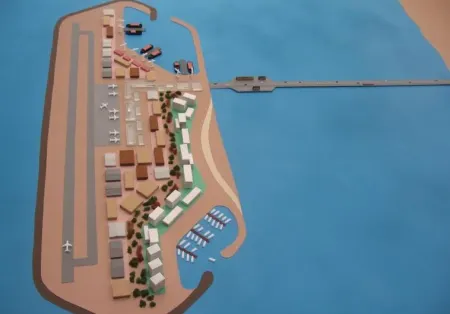
Gaza island model as presented on June 20, 2016. (photo credit:COURTESY/THE ISRAEL PROJECT)
Access to water is a critical enabler of economic activity across many sectors of the Palestinian economy. By channelling significant investments into infrastructure that increases water supply, including desalination facilities, wells, and distribution networks. In the water sector constructing 10 new desalination plants in New-Gaza will provide quick access to potable water. Additional funding will support the development of new wastewater treatment facilities in the New-Gaza. This treated water will be reused, creating vast supplies of affordable water for agricultural and industrial use.
In the energy sector it is possible to rehabilitate existing Egyptian lines connected to New-Gaza as well develop natural gas pipeline to the New-Gaza Power Plant and build new renewable energy facilities. Also the whole North Sinai will benefit from the growing offshore natural gas production in the Eastern Mediterranean. In addition, support to power generation projects in the Sinai - such as 100 MWSolar Energy System - will increase the supply for new developments.
New-Gaza has significant endowments of stone and marble, hydrocarbons, and other minerals. This project will provide support for the development of major resource reserves, such as the Gaza Marine natural gas field, oil fields.
Kilometres of coastline in New-Gaza along the Mediterranean Sea could develop into a modern metropolitan city overlooking the beach, drawing from examples like Beirut, Lisbon, Singapore, and Tel Aviv.
Phase III: Palestine (2-State)
The total area of Sinai is 62000 square kilometer. The North Sinai Governorate covers an area 27,574 km2 (10,646 sq mi) and has population (January 2023) 504,201 with density of 18/km2. It is bordered in the north by the Mediterranean Sea, in the south by South Sinai Governorate, in the west by Port Said, Ismailia, and Suez Governorates, and in the east by the Gaza Strip in Palestine (Rafah Governorate) and Israel (Southern District). Its capital is the city of El Arish.
The Gaza Strip is 365 km2 (141 sq mi) and has a population (2022 estimate) 2,375,259 and its population density is 6,507/km2.
In addition to the sparse population, establishing a New-Gaza in Sinai has its own advantages in that the local population feels a lot of sympathy for the Gazans, even though the top management of the state has good and solid security cooperation with Israel. And after all, Egypt has had a peace treaty with Israel since 1979.
When the humanitarian crisis has been temporarily brought under control (Phase I) and when the reconstruction work of New-Gaza has progressed well in cooperation with Egypt, Israel and international aid organisations (Phase II), it is time to transfer the administration and the responsibility for the withdrawal mostly to the residents of New-Gaza, with the goal of self-governing autonomy and, in the best case, a viable Palestinian state together with the Palestinians of the West Bank.
Successful transformations from international and technocratic government into self-governance draw from core principles - such as representative democracy, the rule of law and anti-corruption safeguards - to build critical institutions and implement policy reforms - such as renewing the education system - are crucial elements in this vision’s strategy.
The aim of Phase III is to encourage the Palestinian public sector to provide the services and administration necessary for the Palestinian people to have a better future. Robust civil society institutions and a free press are important parts of any well-functioning democracy. Preserving and expanding these important institutions within the West Bank and Gaza will require new laws and practices that protect their independence and improve their capacity.
In my opinion it is clear that the road map of the 2-State model has come to a dead end. However, this does not mean that the vision itself should be abandoned as the other alternatives are worse (1-State or Zero option or Status Quo) or unrealistic in the medium term (3-State). The best short-term solution towards the 2-state model is Constructive unilateralism where related actions can be decided by Israel immediately.
The vision of two states and the road map of constructive unilateralism to achieve it is based on the assumption that Israel should move towards the division of the land between the Palestinians and Israelis in order to maintain the future of Israel as a Jewish democratic state. Israel should consider imposing the borders of a future Palestinian state (i.e. two states for two nations). As long as Israel wants to be part of the democratic world – it must give equal rights to all human beings living in the borders of the country. Then, it is for the Palestinians to decide to create their Palestinian State, which is in their interests and they will make their own decisions.
(More in my article Road-map to 2-State solution )
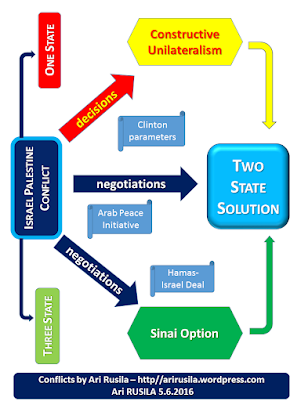
Conclusions
Desperately overcrowded, short on basic resources like fresh water, with its infrastructure intermittently destroyed by Israeli bombing campaigns Gaza is and has been like a giant pressure cooker waiting to explode and this happened on 7/10/2023.Egypt is at the heart of plans to solve the problem on Israel’s and Gazans' behalf.
If Hamas as a political movement is to play any role in a Palestinian government, it must commit to the path of peace with the State of Israel by adopting principles such as recognizing the State of Israel, committing to nonviolence. Hamas, PIJ, and all other militias and terror organisations in Gaza are disarmed; and New-Gaza is fully demilitarised.
For comprehensive peace to be achieved, it is up to the Palestinian people to make clear that they reject the ideologies of destruction, terror and conflict, and unite for a better future for all Palestinians.
The people of Gaza have suffered too long under the repressive regime of Hamas; they have been exploited as human shields and hostages. During its rule Hamas has diverted international humanitarian aid belonging to the Palestinians of Gaza to attack Israel instead of improving the lives of the people of Gaza.
If and when Israel destroys Hamas's military capacity and structures and all Israeli captives and remains have been, it will be possible to turn a new course in cooperation with Egypt, moderate Arab powers and the international community.
The initiative proposes expanding the Gaza Strip to five times its current size and settling all the Palestinian refugees in a state or an autonomy to be established there. Under the initiative, this state or autonomy will be demilitarised. In my opinion annexing part of Sinai to Gaza might partly solve the Arab-Israeli Conflict.
A Day After the Gaza War by Ariel Rusila -slides
[https://arirusila.files.wordpress.com/2024/01/a-day-after-the-gaza-war-by-ariel-rusila-1.pptx ]







